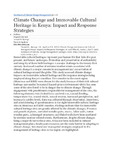Climate Change and Immovable Cultural Heritage in Kenya: Impact and Response Strategies
Abstract
Immovable cultural heritages represent past human life that links the past, present, and future landscapes. Protection and preservation of authenticity and integrity of these built heritages is a major challenge in the twenty-first century. Increased number of extreme weather events associated with climate change is a major concern in management and conservation of cultural heritage around the globe. This study assessed climate change impacts on immovable cultural heritage and the response strategies being employed along Kenya’s coastline. Two counties in the coast region (Mombasa and Kilifi) were chosen for the study because of their rich cultural heritage surrounded by natural hazard-prone environment which has seen some of the sites listed to be in danger due to climate change. Through engagement with practitioners responsible for management of the sites, the following elements were looked into: sea level rise, coastal flooding, temperature rise, coastal winds, coastal erosion, increased precipitation, and increase in acidity levels. Data was collected through observation, interviews, and administering of questionnaires in the eight immovable cultural heritage sites in Mombasa and Kilifi counties. Findings indicate that the immovable cultural heritage sites are greatly affected by the climatic changes. Presence and growth of plants, corroded metallic parts, cracks, fallen walls, rotten wooden parts, submerged structures, and flaked walls have been acerbated by extreme weather-related events. Furthermore, despite climate changes being a major threat to these sites, it has not been included in cultural management plans. Inadequate resources are the main barrier in adapting to climate change. Structural and managerial strategies employed in the management of heritage sites in the region are highlighted.

